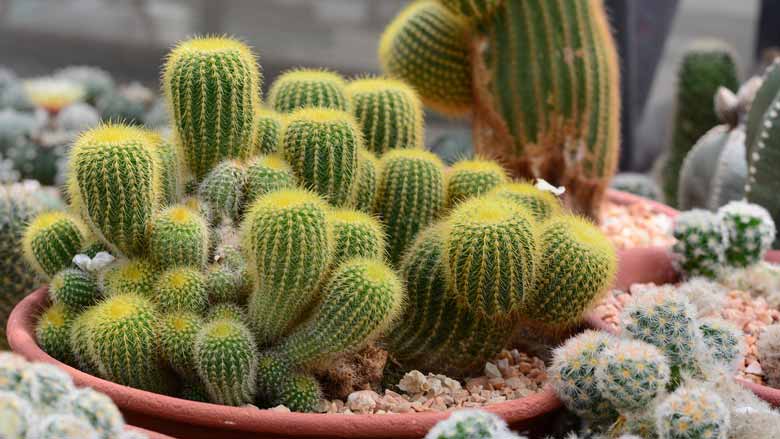Growing cacti from cuttings is beginner-friendly. Opt for Opuntia or Echinopsis for ease. Follow these steps: Take a cutting from the top, let it callus for a few days, then root it in water or soil—transplant when roots are ready. Provide sunlight gradually, water sparingly, and watch your new cactus thrive!
Cacti are an excellent plant for beginners because they’re easy, low maintenance, and can be grown indoors or outdoors!
One of the most straightforward methods for cactus propagation involves growing them from cuttings.
However, growing cactus from cuttings isn’t always as easy as just taking a cutting and sticking it in the soil (but it’s close!).
In this article, I will show you how to grow a cactus from cuttings and how to care for your new plant.
Suitability of Cactus Cuttings for Growth
While cacti can grow from seeds, cuttings produce healthier plants more quickly.
If you are not sure whether or not your plant is a cactus, it will usually be quite obvious if you look closely at its spines.
Cactuses have round-shaped stems covered with sharp needles made of calcium carbonate that protract on the top and sides of the plant.
Most other succulents have leaves instead of spines which makes them easier to distinguish from true cactus species.
There are some exceptions to this distinction as there are some cacti with leaves, such as the Christmas Cactus, the Mistletoe Cactus, and the Pereskia genus.
Best Types of Cactus for Growing from Cuttings
Cacti are divided into different categories based on their characteristics and uses. Three main types of cactus can be grown from cuttings:
The first species is the “Opuntia” or Prickly pear cactus, which includes all sorts of easy-to-grow plants such as Pincushions and Senita.
Prickly pears are among the easiest cacti to grow from cuttings, but they require some special care. As a result, they are not the best choice for beginners.
The second species is “Mammillaria,” which includes all sorts of Pincushion cacti that grow in clumps or spirals and can be propagated easily from cuttings.
These plants do well with average water conditions but require more sunlight than prickly pear cacti.
The last type is “Echinopsis,” which includes all sorts of easy-to-grow plants such as the Easter lily and Echinopsis pachanoi (San Pedro cactus).
These types of cactus do well in average water conditions but require more sunlight than Mammillaria or Opuntia cuttings.
The best choices for beginners are Prickly pear and Echinopsis. Mammillarias tend to be a little bit harder to care for, but they make up for it with their interesting shapes and colors.
How To Propagate Cactus Plants From Cuttings: A Step-by-Step Process
When growing cactus plants, one of the most effective ways to propagate them is via cuttings.
To propagate cacti from cuttings, the main steps are:
- Take a cutting from the cactus.
- Let the cutting callus for a few days.
- Root the cutting in a potting mix.
- Once the cactus grows, transplant it into its container or the garden.
1. Taking a Piece of Cutting
To start growing cactus from cuttings, you first need to take a cutting.
There are various methods for accomplishing this task: employing a clean cut with a sharp knife or shears, snapping off the edges of older pads, or delicately separating two joined stems with your fingers.
Opting for a gentle and precise approach using your hand is often the easiest and most frequently employed method.
You can also take a cutting from a fallen branch, but this may result in an unusual shape of your new plant.
It’s best to leave small pieces for growing cacti indoors; larger ones are better suited for outdoor cultivation as they’re more likely to survive transplanting into potting soil later on.
Cuttings should be several inches long and consist of several clean-cut joints. This ensures that the propagation process is facilitated by well-defined and healthy plant sections, promoting optimal growth conditions.
Remember to take a cutting from the top part of the plant only, because it will grow faster than lower branches!
Taking a cutting from the top portions of the cacti is the best option for propagating new plants.
Choosing the Right Type of Cutting
There are three types of cuttings that you can use to grow new cactus plants.
The first type involves simply cutting off a piece of stem from an existing plant with a sharp knife.
However, removing pieces larger than two inches in diameter may be difficult without damaging or killing your original plant.
Instead, most people prefer to take stem cuttings by removing entire stems along their length at least once during each growing season.
This method is also more practical for propagating large cacti, such as the queen of the night.
Finally, you can propagate new plants by taking leaf cuttings instead of using a stem cutting or removing entire stems at once.
Just like with stem cuttings, many people prefer to remove leaves from their original plant while they are still green and pliable to avoid damaging them.
You shouldn’t take more than three or four leaves per cutting because each leaf only contains enough nutrients for a single growing season before it withers away completely.
Optimal Time for Taking Cuttings
Generally, you should take your succulent cuttings in the spring or early summer. This is when they are most likely to root and grow into healthy plants.
However, you can easily propagate cacti from cuttings at any time of the year.
Just be aware that when you take cuttings in the fall or winter, they will need to spend a little longer time growing roots before sprouting new growth.
It is also best if your cutting has several joints on it, and each joint is at least one inch long. This way, more of its surface area can develop into roots.
It’s also a good idea to take multiple cuttings and leave some in storage for propagating later if your original plants are healthy enough.
2. Callusing Cuttings
After taking the cactus cuttings, you need to let them heal and callus.
Callus tissue forms on the cut part as it heals, protecting the inner layers from infection and preventing moisture loss.
First, you will need to trim any rotten parts of the cactus cutting to make sure no rotting areas are left on it.
Then you must place the cuttings in a warm, dry area with good air circulation.
This may be an open box or tray that can allow some airflow but prevents water from reaching them and keeps out insects and other pests.
The pieces should be left in the box or tray to dry out and callus for a few days. You should see some callus tissue beginning to form after a few days.
Once the cactus cutting has been callused, it is ready to be placed in the soil and propagated.
3. Rooting Cuttings
Rooting cactus cuttings is a great way to propagate new plants.
Many people stick their cacti in soil, hoping that they will root and expand, but this does not always work well because the roots do not grow deep enough, which leads them to uproot with ease.
However, if you take your cutting and give it some time to establish itself before transplanting it into the soil, then there are chances that the plant ends up becoming stronger than ever before!
There are two main ways to root cactus cuttings.
- Water rooting
- Soil rooting
Rooting in Water
To root cuttings in water, you will need to get a plastic or glass container.
Next, fill the container with water so that it covers all but about an inch of the stem cuttings.
Leave your cuttings in this solution for several weeks until they begin to root and grow new leaves on their own.
Once you notice some roots have begun growing from where you made your initial cuts, carefully remove them from the water and pot them up into the soil!
If you are not planning on transplanting these little guys into soil any time soon, then be sure to keep dampening their rooting medium occasionally, as well as giving them enough sunlight.
Rooting in Soil
Prepare a small pot or container filled with well-draining soil to propagate cacti through rooting. Optimal choices include a cactus soil mix or a succulent soil mix.
Place your cutting in the container and press down gently on top of the soil, but make sure that you do not bury the base where you made your cut!
Water your cactus cutting and place it in a bright, sunny spot.
Place the container somewhere that it can receive indirect sunlight.
You can keep the soil moist by watering it whenever it is dry.
One of the most important things to remember when rooting cacti in the soil is that they do not like to be overwatered or watered too often!
So make sure that your plant only gets enough water so that the top layer of soil mix dries out before you water it again.
Duration for Cactus Rooting
It generally takes about two weeks to a month for cactus cuttings to root.
However, the time it takes for your plant to begin rooting depends on many factors, including which type of cutting you are taking and what kind of environment you keep them in while growing new roots!
You can tell when your plant can be transplanted into the soil when the roots have grown several inches long and are off-white or brown.
4. Transplanting a Rooted Cactus Plant
As the roots grow, you should begin to see some new growth on your cutting, which will indicate that they are ready for repotting!
When this happens, carefully remove your plant from its pot and loosen the roots around the edges.
Fill a new pot with cactus or succulent soil mix, and ensure the hole is deep enough so the plant can sit comfortably without having its base buried in the dirt.
Place your plant in the pot and press down on top of the soil gently but firmly.
Once they have been transplanted, wait about one week before watering again.
This waiting period allows the soil time to settle around the roots, which helps reduce shock when you begin watering after this period.
You should only water these plants when they are dry and never let them sit in water.
Caring for a Transplanted Cactus Cutting
After transplanting cacti cuttings into the soil, it is essential to provide them with enough sunlight and water to grow.
Cacti that have just been transplanted will need a few weeks of care before they can be left alone again!
Sunlight Requirements
For the first few weeks after transplanting, you should place your plant in a sunny location that is not exposed to direct sunlight.
They do best in bright, indirect sunlight or partial shade. The cactus should not be exposed to direct sunlight for the first few weeks after transplanting.
After this phase, once your cacti have begun growing new leaves and roots, they can slowly start being moved into brighter lighting conditions.
The amount of time that you leave these plants in full sun will depend on their size! Typically small cactus plants need less light than larger ones.
You should never leave your cacti in direct sunlight for long periods, and you should always make sure that they are not exposed to temperatures below 50 degrees Fahrenheit!
Watering Frequency
Cacti need very little water while growing new roots, but after their root systems have been established, they need to be watered when the soil has dried out.
Cacti typically only need to be watered once every week or two, but you should never leave them sitting in water.
In general, you should only water your plant whenever its top inch of soil is dry and never let it sit in water!
How often you will need to water a cactus depends on how hot and sunny the environment is where you place your plant, so make sure to check up on these factors when determining whether or not your cacti need a drink.
This is also determined by the size of your plant and where you keep them. A small cactus does not require as much watering, while larger ones must be watered more often.
While caring for your new plants, you should remember: not to underwater or overwater them but only water when the top layer of soil has dried up.
When watering your plant, be sure to give it enough water that the top layer of soil feels moist but not wet!
Final Thoughts on Growing Cacti from Cuttings
Growing cacti from cuttings is a simple process. It requires patience, but the process is easy to complete.
Cuttings are a great way for you to grow cacti of your own choosing, and they can be easily turned into new plants with ease.
If you are looking at ways to get more out of growing succulents or want an exciting type of plant that will bloom for you, then growing cactus from cuttings is an easy task that will provide excellent results when completed.







